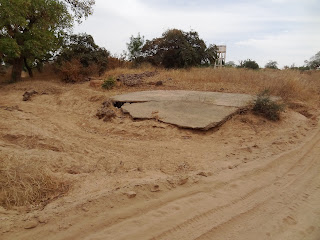I am working with Trees for the Future, a small (annual
budget is less than $2 million dollars) non-profit organization / non-governmental
organization (NGO) headquartered in the United States. They share the development space with
thousands of other NGO’s, all of which have different philosophies and
approaches to assisting third world people and countries.
At times, I encounter these other non-profits working in the
region. Though I have not yet found an
organization that has implemented the perfect development approach, some non-profits
are more effective than others.
A case in point is a rather large non-profit that has a
history of creating projects in Senegal.
I mention this non-profit because part of the space where I am currently
creating a forest garden with my counterpart previously was the site for a
rainy season dam.
This NGO had the “brilliant” idea of trying to dam a rainy
season river to create a water source that would last a few months into the dry
season. In doing so, the executives of
this NGO had hoped to facilitate the creation of a gardening co-operative for
the local village. They even created two
large composting pits that my counterpart is currently using. On its surface, damming a river seems like a
great idea. However, this is a big
undertaking that has more widespread ramifications when one considers that no
village lives in a vacuum. There are
many other villages, some downstream from a potential damming site. This is a project that probably was best left
to the national government to pursue as infrastructure development.
Nonetheless, the NGO attempted to dam this river. Twice.
Both times the dam failed. I
don’t know about you, but building a dam is not rocket science. It doesn’t take a genius to construct a dam
that will withstand the forces of a surging river. Evidently, they didn’t have the money to hire
an engineer, and the dam failed… (and the town rejoiced).
 | |
| The remnants of the dam near my counterpart's garden. |
Their money would have been better spent by digging a well,
complete with a solar panel pump. It
sure would have beat the money constructing two poor quality dams that got
destroyed.
Another NGO that is working in the area is having better
luck, at least for now. Their research
revealed two major problems: an increasing number of young people leaving the
Kaffrine prefecture in Senegal, and the ever-present problem of food
security. Their solution for both of
these problems was to enclose a few hectares with metal fencing so that the
space could be converted to gardening and crop production activities. This included installing a drip irrigation
system for dry season gardening. During
the rainy season, the space will be used for field crops (corn, millet,
peanuts). Thus, the project will create
a few jobs for the young people in town, and yield something productive from
the vast amounts of land that exist in Africa.
 |
| The drip irrigation system for the tomatoes. |
This project is in contrast to the work that Trees for the
Future is doing. For one, the fencing is
permanent wire woven fence. There is no
plan to create a more sustainable, living fence model (with trees). Second, there is no incorporation of trees in
the cropping system. Fruit trees such as
mangoes could easily be planted and would produce a valuable agricultural commodity. In addition, trees would have the ability to
recycle soil nutrients in a way that annual vegetables are unable to do. Certainly, the simplicity of the current
system is attractive to their financial supporters, but there is an opportunity
to do so much more. Some participants are experimenting with
manure and chemical fertilizer, but this is not a focus of the project. I imagine also that crop residues will be
burned in the typical African custom, rather than being recycled into compost
and returned to the soil.
We live on a vast planet where we are all free to do as we
wish. Independence is a major value that
most of us take for granted. However,
the planet is highly interconnected, and we could achieve better results if we
cooperated and worked together on the world’s problems. Perhaps then our results would be amplified and
we could achieve something that no single organization is able to do on its
own.

No comments:
Post a Comment